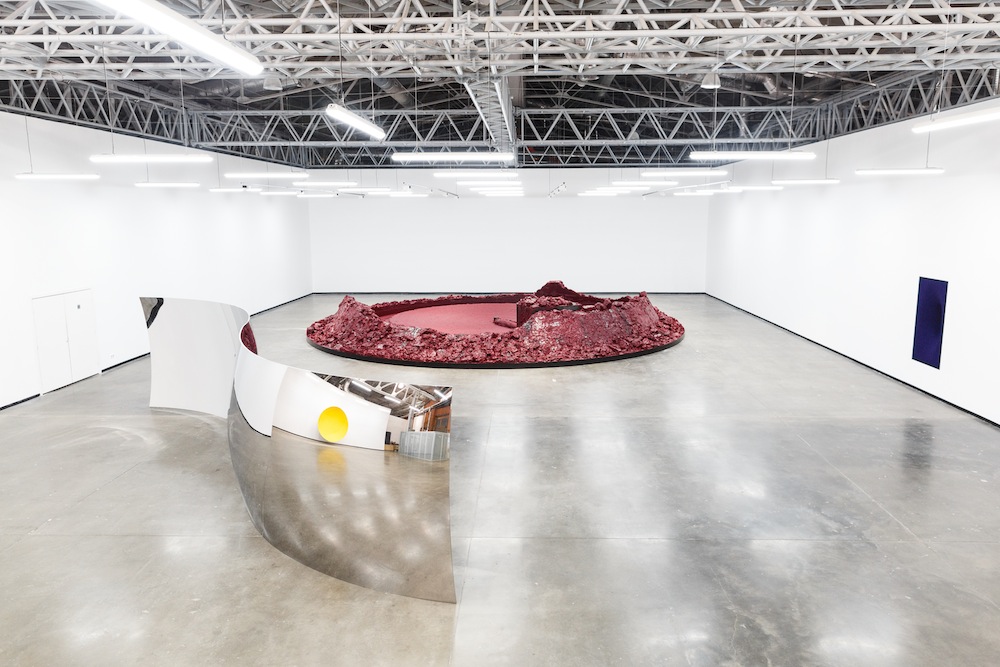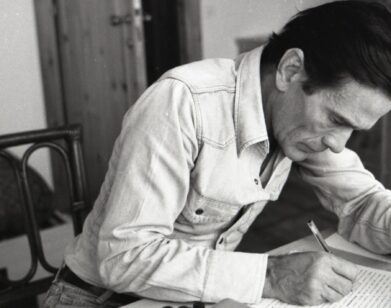Anish Kapoor Colors Russia Red
Last week, on the opening day of London-based artist Anish Kapoor’s first Russian solo show at Moscow’s Jewish Museum and Tolerance Center, Europe’s precarious current events hung heavily in the air. As the migrant crisis has escalated, Kapoor, who was born in India to a Jewish mother and Hindu father, has been an outspoken advocate for providing aid and open arms; meanwhile, Russia has kept its borders closed. Separately, Kapoor has had to grapple with repeated anti-Semitic acts of vandalism on his sculpture Dirty Corner (2015) at Versailles. Prior to the opening, a court ordered him to cover up the third instance of vandalism on Dirty Corner. (He had obliged the first two times, but refused after the third, and was taken to court by a right-wing politician. He will comply with the ruling, using gold leaf to conceal the slurs.)
Titled “My Red Homeland,” the show in Moscow is all the more intriguing for its time and place in that Kapoor, 61, has stated firmly that his artwork does not have an inherent political message. The main sculpture on display, first staged in 2003 and from which the show takes its name, is comprised of a monumental pile of red wax, eroded over time by an enormous, rotating sledgehammer-like apparatus that completes a 360-degree rotation once per hour. Though fully aware of the historical weight of the color red in Russia, the artist intends the thick, clumpy wax to symbolize our universal, animal insides.
Kapoor also included three large-scale works that represent other longstanding interests. One of many mirror works, S-Curve (2006), is a massive sheet of stainless steal metal bent into two concave curves, capable of simultaneously reflecting itself and its setting. The oldest and newest works on view–My Body Your Body (1993) and Shelter (2007)–each demonstrate Kapoor’s fascination with “voids,” a recurring theme in his practice in which he highlights empty spaces through the absence of material. My Body Your Body focuses on the negative space of an apparent recess behind a dark blue canvas. The recess is the inverse shape of a pregnant stomach, a motif Kapoor has used elsewhere. From a distance, Shelter is a flat yellow circle; from the side, it is a concave shape jutting out from the wall.
We sat down with Kapoor at the Jewish Museum and Tolerance Center shortly before the public opening.
RACHEL SMALL: To start out, I’d love to hear background on how the Jewish Museum and Tolerance Center first approached you and how this show came to fruition.
ANISH KAPOOR: I’d shown in the space before when it was Garage, just one work. But I knew from the beginning that I’d wanted to show My Red Homeland, partly for naughty historical reasons, but also because I think it’s a work that’s fairly central to my proposition, in the last few years.
SMALL: It literally tells time, and in a sense as it moves through space, it transforms this object so it becomes unstable. Since you started working on this, have you given any thought to the history of modern art in Russia, which has always had a politically charged overtone? Especially in light of the migrant crisis, which has escalated so much in the last few months…Russia is being particularly conservative about letting in refugees. Have you thought about how your work may take on a more political tone in this environment?
KAPOOR: The other day Ai Weiwei and I made a “walk” through London. It was an idea that we came up with over lunch one day. Since we’d danced “Gangnam Style” with each other [in 2012, as part of a separate political protest], I suggested to him that we should do another crazy project. And we sat down, and this is what came up: Going for a walk. It’s interesting how small acts have resonance with the political moment. One of the things that I feel we’re incanting in that walk is the idea that for a person, a family, especially with children, to take themselves up and leave their country, and make a journey, a perilous journey, a dangerous journey—that is an act of huge inventiveness, huge creativity. The countries that welcome them, welcome in courage and creativity. And those that don’t, simply don’t, for all kinds of perfectly unreasonable, bigoted reasons. The U.K., where I live, happens to be less enlightened in this area. I feel that that act of walking across London for Ai Weiwei and me is like making a work evoking the creativity of these people wandering across the world. So, yes, as to politics per se, I feel I am drawn to a political voice. But really I’m not making art about politics. I think art sits in a space slightly apart; when it’s too tied to quotidian questions, I think it [makes for] less good art. Not always, but often.
SMALL: And [ties to quotidian questions] make it less timeless as well.
KAPOOR: And I’m interested in the long-term. I want to make work that will be able to have a voice onward and not just for the short period of time that these questions or problems [remain relevant].
SMALL: I was thinking even in terms of how these specific works that are debuting at the Jewish Museum, in Moscow, right now, may be read by local people or by visitors as having a more political bent.
KAPOOR: I mean, the works point in certain directions, but they’re not prescriptive in their meaning. I think that means that they allow for a possible openness of interpretation and that can be responsive to the time in which the work is shown. It’s not incidental that I’m showing My Red Homeland here in Russia. In one way it’s slightly naughty, and in another way, I quite like the idea of engaging with the question of: What is this emotive word, homeland? Whose homeland? What homeland? Do we carry it within us, that red stuff? It’s a very odd material, because it’s somewhere between inside and outside. We recognize it as part of us, and at the same time it’s out there, so that physical in-between-ness is something I’m interested in. Of course, homeland is similar, it’s also in between, it’s a place, a status, but it’s also an internal condition of home, where I belong, who I am, et cetera.
SMALL: With the cycle element, it has like a lot to do with the womb and fertility, [and] the media seems to describe the controversy around Dirty Corner with the assumption that people are interpreting it as female genitalia. I couldn’t help but think about how much modern and contemporary sculpture and painting unabashedly represents phallic symbols and how no one ever seems to take issue with that.
KAPOOR: It’s interesting. You know, all I ever said about Dirty Corner in Versailles is the following: “She is reigning supreme, lying there on the lawn.” End of quote. And it was turned into, “Marie Antoinette’s vagina,” and all that business.
SMALL: And why are people so scared of vaginas?
KAPOOR: Had I said “He is sitting there,”… you know, our cities are full of phallic objects. It’s ubiquitous. I’ve never heard of a phallic object causing offense. And yet, a negative form that hardly bears a relation to any vagina I’ve ever seen in any case…it’s just ridiculous. I suppose my gesture of leaving the graffiti on the piece is, at one level, quite provocative, but why should I just pretend that it didn’t happen and just scrub it off?
SMALL: It’s also so bizarre to me that the emphasis wouldn’t be on trying catch whomever did it.
KAPOOR: It’s extraordinary. The day before yesterday, I was taken to court by a French deputy in the government and he managed to get a court hearing in [snaps fingers] days, just like that. We have had a police case running to try and find out who did this in the first place for more than three months…They haven’t provided any information as to who did anything at all.
SMALL: That’s so insane. Well, going back over the highlights of your career, your big break was in 1990 at the Venice Biennale, and you’ve had so many seminal exhibitions and installed a number of major public sculptures since. I was wondering how or if, over the decades, you’ve perceived any overarching changes or themes regarding the reception of your work, either in Europe or India or the United States, or elsewhere?
KAPOOR: You know, it’s very hard to observe one’s self. But, I’ll say only that, one of the things about being an artist is that you conduct your education in public. You do your thing, you might rehearse it in the studio, you might make it in the studio, but really when you bring it into the world it’s a public object. You say, “I’ve grown in this way, or I’m trying to grow in this way or I don’t know what I’m doing in this way.” That is, as I say, a public process. One of the things that time does is to equip your public with a history of the work, so that they can understand how to look at it, and what to look at. That is what you do. You educate your public to look, to see in a particular way, so, that is a huge advantage over, and a big step away from being a young, beginning artist, where you have no ammunition with your public. That is a big difference.
“ANISH KAPOOR: MY RED HOMELAND” WILL BE ON VIEW AT THE JEWISH MUSEUM AND TOLERANCE CENTER IN MOSCOW THROUGH JANUARY 2016.







